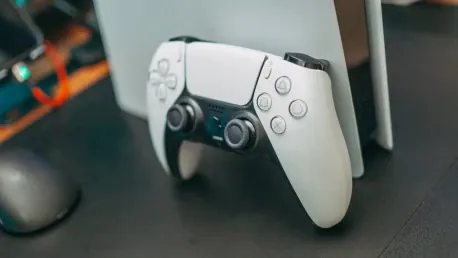Sony’s decision to develop its own AI hardware for the PlayStation 5 Pro (PS5 Pro) marks a significant shift in the gaming industry, showcasing the company’s ambition to lead in next-generation gaming technology. Instead of relying on technology from AMD, which provides the CPU cores and much of the GPU technology for the console, Sony has chosen to create a specialized solution tailored to its needs. This move underscores the critical importance of AI-driven graphics upscaling in modern gaming and Sony’s desire for greater control and customization over the gaming experience for its users.
The Importance of AI-Driven Graphics Upscaling
AI-driven graphics upscaling has become a cornerstone of modern gaming, significantly enhancing visual quality and performance, which is essential in delivering immersive experiences for gamers. Technologies like Nvidia’s Deep Learning Super Sampling (DLSS) and Intel’s Xe Super Sampling (XeSS) utilize dedicated matrix math hardware in their GPUs to achieve superior upscaling results. These technologies leverage neural networks and machine learning (ML) to upscale lower-resolution images into higher resolutions while maintaining image quality and smoothness. In stark contrast, AMD’s upscaling technology, FidelityFX Super Resolution (FSR), lacks such dedicated matrix math hardware, impacting its performance and quality in the upscaling domain.
The development of AI hardware at Sony reflects the company’s commitment to delivering top-tier gaming experiences by pushing the boundaries of graphics technology. Sony’s lead architect for PlayStation consoles, Mark Cerny, emphasized the need for specialized AI hardware to meet the demands of next-generation gaming. This prompted the initiative to incorporate this hardware into the PS5 Pro, a project that began in earnest in 2020. The project faced two crucial decisions: whether to implement a dedicated Neural Processing Unit (NPU) or enhance the existing GPU, and whether to license the technology or develop proprietary hardware. In both cases, Sony opted to develop its own technology, driven by a goal to achieve a staggering 300 trillion operations per second (TOPS) of ML performance, equivalent to the raw ML performance of an Nvidia RTX 4060 Ti.
Customizing the RDNA Architecture
To achieve its ambitious goals for AI hardware, Sony embarked on a challenging journey to modify AMD’s RDNA 2 GPU architecture, resulting in a unique “custom RDNA” architecture with specific enhancements to the RDNA shader core and memory systems. However, simply adding matrix math capability to the original RDNA 2 shader core proved insufficient due to the substantial bandwidth requirements of matrix math. Therefore, Sony developed a custom on-chip memory solution and tiling algorithms that allowed complex matrix math operations to be conducted entirely on the GPU, effectively avoiding costly performance hits associated with accessing system memory.
This four-year development journey culminated in the creation of hardware capable of delivering on Sony’s advanced AI upscaling software, known as PlayStation Spectral Super Resolution (PSSR). PSSR serves as Sony’s counterpart to Nvidia’s DLSS and Intel’s XeSS, standing apart from AMD’s FSR, which lacks a foundation rooted in machine learning. Mark Cerny reflects on this intensive development process positively, noting that the decision to create bespoke technology has paid off handsomely, resulting in excellent performance outcomes and significant learning about the potential of AI in enhancing game graphics.
Strategic Focus on Machine Learning Capabilities
Sony’s strategic decision to develop proprietary ML hardware, rather than relying on external technologies or standard hardware, underscores its prioritization of control and customization over its gaming consoles’ performance and features. This focused approach ensures that Sony remains untethered from permanent licensing agreements, allowing it to continually refine and improve its technology to better suit the evolving demands of its gaming platforms. Such a move demonstrates the increasing emphasis on machine learning and AI upscaling within the gaming industry, an emphasis that Sony evidently considers of greater import than even core GPU architecture.
The development of proprietary AI hardware positions Sony ahead of the curve in the rapidly evolving gaming landscape. By engineering a custom RDNA architecture coupled with dedicated memory solutions, Sony ensured that its solution was optimized specifically for its gaming consoles’ unique needs. This approach helped circumvent the limitations inherent in generic, licensed technologies. Consequently, this move enabled substantial improvements in upscaling technology while positioning Sony favorably for future advancements in AI-driven graphics, ensuring sustained innovation and leading performance capabilities.
AMD’s Lag in AI Hardware Integration
Sony’s choice to develop its proprietary AI hardware for the PlayStation 5 Pro (PS5 Pro) signifies a notable shift in the gaming landscape. This decision reflects Sony’s goal to be at the forefront of next-generation gaming technology. Historically, Sony has relied heavily on AMD for both CPU cores and a significant portion of the GPU technology in its consoles. However, with the PS5 Pro, Sony is breaking away and opting to build a specialized solution tailored specifically to its needs.
This strategic move highlights the growing importance of AI-driven graphics upscaling in contemporary gaming. By developing its own hardware, Sony aims to gain more control and customization over the gaming experience it offers its users. This change is not just about following a trend; it’s a deliberate effort to enhance gaming performance and user experience. By taking this direction, Sony emphasizes its commitment to pioneering advancements and setting new standards in the gaming industry. This innovative step ensures that the PS5 Pro will stand out in a highly competitive market, offering something uniquely superior to gamers.









